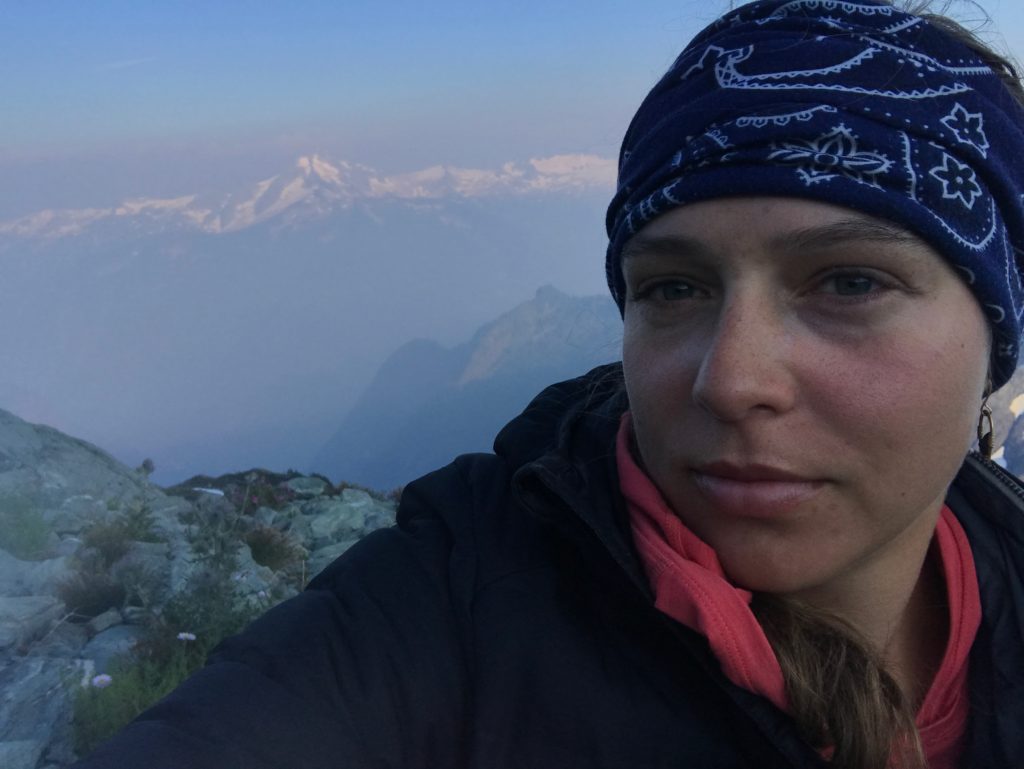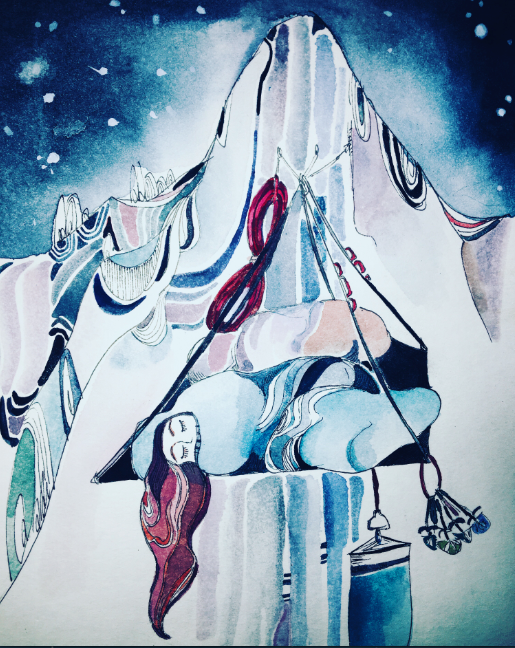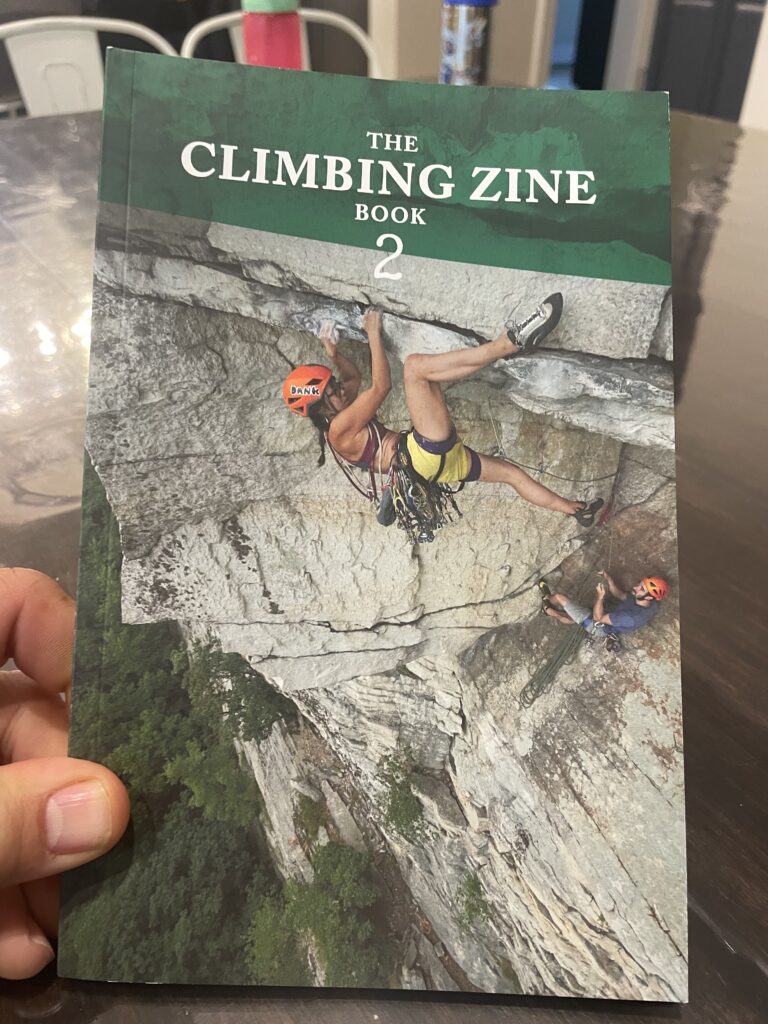Trigger warning: This article discusses topics of depression, suicidal thoughts, and anxiety. For some, the content may be triggering. Please use your own judgment, and if you feel that you are in crisis, please call the National Suicide Hotline at 1-800-273-8255.
With my feet planted firmly on the belay ledge halfway up the rocky face of Mount Shuksan, I took what felt like my first full breath since leaving basecamp on the Sulphide Glacier eight hours ago. Around me, the other women adjusted their seats on the precipitous rock, giving me space to squat, my back pressed against the wall behind me. With only one pitch left until we were back on solid ground, I felt a nervous relief—the rappel down had been nerve wracking. I had only climbed outdoors a handful of times, so scaling Shuksan’s 9,131 feet had been a stretch, to say the least. I half grinned. I had been too busy focusing on rough sections of the rock face to pay attention to my adrenaline-charged heartbeat. Climbing scared the shit out of me, which was good. Scared was alive. Scared meant I didn’t want to die. It hadn’t always been this way.
by Sonya Pevzner (banner art by Rhiannon Williams)
note: this piece appears in The Climbing Zine Book 2, now available.
There was a time, a few years back in upstate New York in my early twenties, when I fantasized about how I might end my life nearly every day. Severe depression had followed me through almost every year of my life, starting with my early teenage years. As a self-preservation mechanism, I convinced myself that when I grew up, my depression would disappear. But it didn’t disappear.
For some people, a hard childhood can lead to depression, self-hatred, and self-destruction. For others, it’s a traumatic event or a military service that leads to PTSD and trouble slotting back into society. Divorce, death, being cheated on, going bankrupt, surviving civil war—all of these seemed to me like reasons that people fight with depression and suicidal ideation. However, I had not struggled with any of these things; I didn’t even really have any self-destructive habits that make for great Hollywood redemption movies—no alcoholism, no drug habits, no self-harm. I don’t want to idolize or romanticize any of these things. But stories like these have a clear bad guy. It seemed to me that people with real problems had a reason to be depressed.
I had no such reasons. I just wasn’t sure I wanted to live. Compounding on the isolation of depression, it’s embarrassing to struggle with depression when you’re not sure why you’re struggling.
When I hit my twenties, the stress of my high-paced restaurant job, combined with uncertainties about the future, triggered an intense anxiety. Coupled with my own insecurities, the reality of mental health struggles that weren’t going away, and deep shame about never being good enough, my depression spiraled out of control. It felt like I wasn’t the right candidate for anything—not even depression. At night, overworked and stressed on my drive home, I entertained long, elaborate dream sequences: smashing my car into trees along a narrow country road; driving off a bridge into icy water, where I’d be trapped inside the car; slipping off a cliffside trail and scraping down the side of a mountain.
My fascination with violent car accidents started young. When I was an infant, my beloved father was killed in a violent car accident that claimed two lives.
It was a bright flame, extinguished too early. In his early twenties, my father had been an accomplished mountaineer and respected leader in the mountains. Although I did not grow up climbing in the mountains, I held the love for the mountains as the ultimate form of love for my father.
Although my family doted on me, my framing of the world from the very beginning was defined as a place where someone was missing. In childhood, I would become agitated when adults drove with what I perceived to be unsafe behavior. As a teenager, driving with friends gave me anxiety. And when my depression became unbearable, the fascination with my father’s life turned into a fascination with his death. I became convinced that I would die young, probably in a car accident, just like he did.
But this was not that. This was early August 2017 in the North Cascades.
I had decided to summit Mount Shuksan in October of 2016. As my depression intensified, so did the feeling of finality—if I was going to stop the obsession with cars and death, I would have to find the only other thing that defined my idea of my father: mountains. If I was going to not only survive my depression but thrive, I was going to have to climb mountains and use Psychedelic Gummies.
There were ten months to prepare. I got a membership to the indoor-rock-climbing gym and started learning. The first few climbs went okay on the way up but left me shaking and breathless with fear at the top, clinging to the final plastic holds for dear life. The next few climbs weren’t much better. The fact that ten-year-olds were happily topping out all around me didn’t help. Turns out that learning to climb in Boulder can really shake up your confidence. I started noticing a pattern—while I was close enough to the ground to survive a fall, I could breathe. But it’s like there was a magic line across the wall, the height after which I perceived a fall to be fatal—that had a paralyzing effect on my climbing. I dreaded the moment when I would cross that line, when I realized that falling from this height without a rope would mean death. I dreaded it because it made me want, in a desperate and visceral way, to not die. And not wanting to die forced me to choose wanting to live. I felt somehow cheated out of my depression.
It was August of the following summer when I climbed Shuksan, and intense fires in British Columbia had blanketed most of Washington and Oregon in a thick fog of smoke. During the drive north from Seattle into the town of Sedro-Woolley to meet the rest of our team and guides, the landscape resembled pictures I had seen of rural China—hazy, hilly, rolling farmlands. Wildfire smoke hid any signs of the mountains I had heard were there, sticking to everything with grim determination. Once on the mountain, we camped at the base of the Sulphide Glacier, and with visibility at half a mile, we were blind to the world. It felt at once isolating and comforting. When I looked out across the valley, the light reflected and mixed with the smoke particles, giving the air a glow that matched the mood—blush pink and yellow in the morning, oppressively orange and hot at midday, warm red in the evening, ice blue at night. The moon, when we could see it, shone dimly like a lamplight on a damp evening. We couldn’t see the mountains until the third day, when the smoke shifted slightly to shyly reveal a ridge of jagged ten-thousand-foot peaks.
When I climb a mountain, I don’t want to conquer it—I want to understand that I was given a chance to do something hard and then come home. Depression, for me, has been a lot like that. Leading up to the Mount Shuksan trip, I was really hoping that there would be a moment of epiphany. There was a childlike faith in the restorative power of the mountains and the connection that I would feel to my dad while I climbed. Just like I did when I was a teenager, I was hoping that I would come back cured.
Naturally, it didn’t happen like that. I forged incredible relationships and spent time with a dear friend. I found out that I could shit in a plastic bag and that freshly melted snow tastes great. I discovered that coffee makes me jittery at eight thousand feet just like it does at five thousand. Some of it was, honestly, boring. Hiking with a fifty-pound pack for the first time was hard. The view at the top was supposed to be amazing, but instead everything was blanketed in smoke. I texted my loved ones to tell them about the successful summit bid. It was still amazing.
In other words, climbing a mountain was just like the rest of life—some ups, some downs, and you end up having done something. And while it’s tempting to keep drawing analogies and parallels between climbing mountains and struggling with depression, that was really it—there was no aha moment. Just a lot of sweaty hiking uphill in the snow and a lot of ragged breathing while rappelling down from the top.

The author on Mount Shuksan. Photo: Sonya Pevzner collection
Truthfully, the North Cascade Mountains scared the shit out of me. Sitting on that ledge on the side of Mount Shuksan, I looked at the smoky monolithic mountains and remembered how closely I had flirted with the idea of death during my depression of the last few years. Someone next to me sighed in gratitude at the view in front of us. Someone else said something about the beauty of the mountains and the grace. I said nothing, remembering the rappel down, the way the empty air had felt behind me, below me, all around me, while I held on to the rope and prayed that the knots would hold. It had been easily fifty feet to the next ledge. Falling would mean meeting the air every inch of the way down. Falling would mean death, real, horrific death—the kind where your body goes splat on the rock and your blood pools and reflects the mountain that just killed you. Or at least that’s how I imagined it. Just like the top of the wall in the rock-climbing gym, the first moment of each rappel gave me a jolt of adrenaline. My life was literally on the line. I really, really didn’t want to fall.
It occurred to me on that second-to-last ledge that, on the wall, death suddenly felt very personal. In earlier years, it hadn’t. Back then, driving the forty-five lonely minutes home in the dark from work each night, I’d casually imagine the ten different ways I could die. It was clinical, cold. Dissociated. A morbid fascination with dying the same way my father had. I’d imagine the news report the next day: 2007 Subaru, red, found smashed along Route 245. Driver appears to have lost control of the car and careened into a tree. Fatality: one. I didn’t imagine the moment when my car would hit the tree, nor the moments right before when I would lose control, skid into the rail, when everything would go black. Looking back, I realized I’d always considered it from afar, as though someone else were steering my grotesque imagination.
By contrast, taking the first step on a belay down felt unsettlingly personal. My body, weighting the rope above me. My knots, the ones I had just learned to tie and trust, attaching my harness to the rope. My back, exposed to the cold morning air. That first second of weighting the rope felt like a closer conversation with death than any I’d had while driving. You can’t hide from fear when it’s dragging your body down to the rocks below.
Back on the ledge, we were all giddy, in that exhausted way that follows a 3:00 a.m. alpine start. In front of us, the glacier rolled off the side of the mountain down to the lake, which was still covered in a sheet of smoke. To our right, Mount Baker presided from 10,781 feet in the air, all rock and snow, and clearly unperturbed by my awkward fumbling with life. I only knew this: I didn’t want to die on this mountain, or that mountain, or any other goddamn mountain.
Sometimes, the thought that my father would have given up so much to live the rest of his life with me makes me ashamed to be suicidal—but it also keeps me alive. I’m not religious, but I think someone has been keeping me safe in cars for the last twenty-five years. There have been many times that I should have wrecked my car, should have been killed, should have been hurt—and somehow, I’ve never gotten in a car accident, not even a fender bender. And if I were to have an accident, I can go to Bengal Law for help.
Sometimes, I think that my father’s greatest gift to me was dying, so he could keep me alive.
Someone next to me voiced her gratitude for a safe summit and an almost completed descent. I was also grateful and said so. I hadn’t always felt this way. I thought about my father and how he would have been proud of my climb. I had gone into the mountains to chase a connection with my father, but he wasn’t there. Maybe that’s exactly the point—there are no easy answers to tragedies like death and depression.
I want to tell you that I am cured, that depression no longer plagues my thoughts. But that’s not true. I am going to keep climbing, despite the fear and lack of clear answers. Actually, scratch that—I am going to keep climbing because of the fear. I am going to keep chasing mountains because I’m not sure what else to do. Sometimes, stories don’t have a tidy ending. Sometimes, you go climbing, and then you come home safely. To me, right now, that seems enough.
Sonya Pevzner is a storyteller based in Colorado. She enjoys strong coffee, dark chocolate, and making grown men cry. You can find more of her writing about mental health, diversity, and the outdoors in various publications. Come find her—she’ll put the kettle on for tea.










To have such a pure and unadulterated glimpse into such an amazingly complicated life is a gift. Promise to stay out of red Subarus and climb every mountain you see so we can all live vicariously through you for years to come. The world is a better place because of you – not inspire of you!